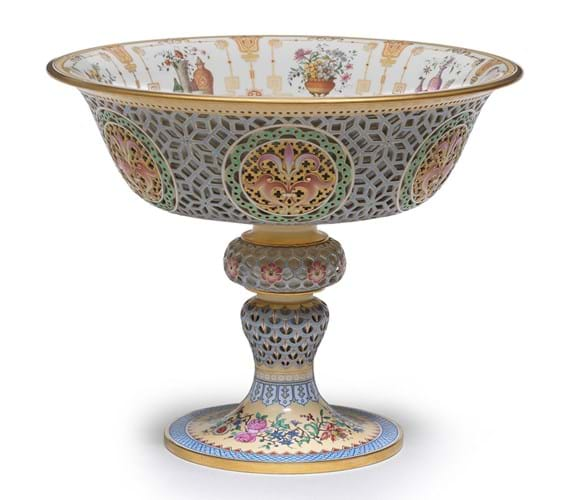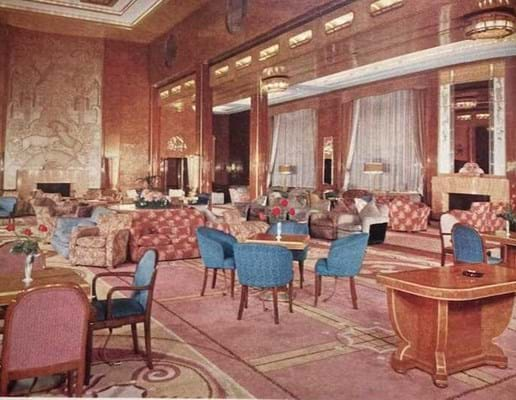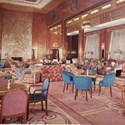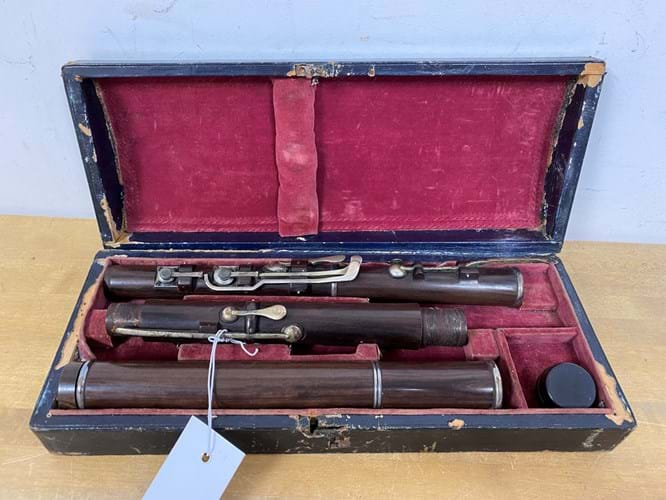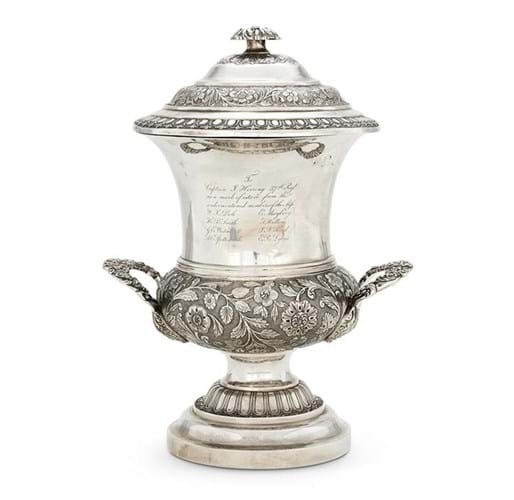1. Victorian bat brooch – £16,000
Although, thanks in part to Bram Stoker’s Dracula (first published 1897), bats have acquired a reputation as ‘creatures of the night’, in many cultures they are viewed as symbols of luck or reincarnation.
In Chinese, the word ‘fu’ for bat is a homophone for happiness while in Japanese the bat has the same character as luck.
Bats began appearing in western jewellery design as part of the 19th century craze for chinoiserie. The fashion reached its peak in the Art Nouveau movement. René Lalique decorated his showcase at the Exposition Universelle of 1900 with bats.
This late Victorian diamond and ruby brooch proved hugely popular at the Jewellery and Watches sale held by Lawrences in Crewkerne on July 7. Estimated at a lowly £250-350, it raced away to bring £16,000.
2. Sèvres Chinese style porcelain coupe – £70,000
Although this 10in (25cm) porcelain coupe has some of the attributes of 18th century Qing porcelain it was made by the Sèvres factory c.1845.
It was in November 1831, that the designer Hyacinthe Régnier was paid an advance to create elements of a ‘déjeuner Chinois'. His inspiration was drawn from the Chinese objects he would have seen in the famous sale of Chinese art of the Parisian art dealer F Sallé which began on 11 April 1826. Among them were examples of the double-walled reticulated porcelains made during the reign of the emperor Qianlong.
Le Goût Chinois range proved a great success and ever more complex variations on the theme were commissioned. The original designs for this coupe, produced in 1842, survive in the Sèvres archives with this particular piece delivered on November 19, 1845 at a cost of 650 livres to Prince Philippe, Comte de Paris (1838 -94). At the time he was heir apparent to the throne although by 1848 the Second Republic had been declared and he spent most of his later years in exile in England at York House, Twickenham, then at Sheen House, near Richmond, and latterly at Stowe House.
The coupe, still housed in its original leather case, appeared for sale as part of the Five Centuries of Ceramics sale at Bonhams on July 7. Estimated at £15,000-20,000, it took £70,000.
3. Art Deco suite – £4800
According to family history, this Art Deco four-piece suite offered by Mander Auctioneers in Sudbury on July 8 has an ocean-going history. The three armchairs and a matching sofa are thought to have been made for the RMS Cunard White Star Line cruise ship The Queen Mary, which was launched in 1936. An image of the main lounge appears to show them in situ.
They were removed in the 1960s by a family member who worked for Cunard when the boat was decommissioned. The suite – unexpectedly heavy, said the auctioneers, presumably to stop it moving while sailing in rough sea – has been re-covered at least twice, according to the family. It is currently covered in a cream fabric although would originally have sported maroon and pink velvet.
Entered for sale in Suffolk with modest hopes of £100-200, it brought £4800
4. Eight-key rosewood flute – £3100
Popular in the first decades of the 19th century, the eight-key flute is something of a transitional instrument, retaining many of the characteristics of the earlier baroque flute but also featuring some of those of the modern instrument.
Among the best-known makers at the time was Rudell & Rose, a partnership between the London flute player and instructor George Rudall and Edinburgh wind instrument maker John Mitchell Rose that thrived from 1821-50.
Interest in the eight-key flute as an orchestral instrument waned in the Victorian period in favour of the ‘modern’ flute based on the designs of Theobald Boehm of Bavaria.
However, the eight-key flute did remain popular with folk musicians. Since the revival of Irish music in particular in the 1970s they have been eagerly sought after. Only occasionally are Rudall & Rose eight-key flutes seen at auction.
The example here, in rosewood and white metal with the Rudall & Rose name and 15 Plaza, Covent Garden address to one end, was offered at Ramsay & Cornish in Edinburgh on July 9 with an estimate of just £50-80. It came in its original box.
Plenty of bidding followed before it sold at £3100.
5. Anglo-Indian silver trophy cup – £1000
Unlike the later ‘kutch’ silver that was made by Indian craftsmen, Anglo-Indian silver was typically made by English and Scottish silversmiths who relocated to the subcontinent and set up workshops and shops in the major cities. Many of the forms they created mirrored those that were popular in Britain at the time although some were new, necessary for life in a challenging climate.
A large collection of Anglo-Indian pieces by a range of silversmiths was offered for sale at Dreweatts in Donnington Priory, Newbury on July 7.
The 43 lots included this trophy cup and cover made by Twentyman & Co in Calcutta, c.1835. Standing 13½in (34cm) high, it is chased with a floral band and engraved To Captain J Herring 37th Regiment as a mark of esteem from the undermentioned member of the Mess.
Herring had arrived in India in 1805. He rose to the rank of lieutenant during the Nepal War in 1814-15 and lieutenant-colonel when his military adventures in the 37th Regiment of the Bengal Native Infantry took him to Afghanistan. During the First Afghan War he was killed by tribesmen at Haidar Khel in December 1839 and was buried in Kabul two days later.
The 54oz trophy sold for £1000, the lower end of expectations.
6. Document signed by Sir Walter Raleigh – £22,000
The sale of Rare Books, Manuscripts, Maps & Photographs in Edinburgh on July 13 included this document signed by the adventurer and courtier Sir Walter Raleigh (1554-1618).
Penned in a secretarial hand on the Isle of Wight, August 15, 1580, the 14-line text references Raleigh’s preparations to travel to Ireland to help crush the Desmond rebellion – the venture which propelled him into the favour of Elizabeth I. Raleigh signed the letter W Rawley.
It was during the suppression of the rebellion in Kerry that Raleigh and his men discovered, among the possessions of the dead, a collection of secret letters. Ordered to return to London to present his findings at court, he quickly established himself as a leading light at Elizabeth's court.
Raleigh’s signature is extremely rare and this example is perhaps the earliest known. It predates his ‘earliest surviving letter’, one written to William Cecil, Baron Burghley, lord treasurer, from Cork in February 1581.
Estimated at £15,000-20,000, it took £22,000.



